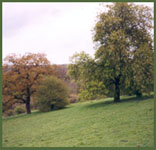
| The site is generally undulating and falls from a high point of 95m. OD in the north-west to 60m. OD in the south. There are two prominent ridge lines running east-west containing a small stream. The views from the higher ground are unusually long for Essex making the area highly attractive visually. The majority of the site overlays the Bagshot and Claygate Beds consisting of sandy loam and pebble beds, overlaying London Clay which outcrops and creates a spring line along the lower slopes, which are therefor seasonally wet. The woodland meadow at the extreme south is exceptionally wet. |
 |
 |
The whole of the site was formerly farmland, most of which was grazed with some fields converted temporarily to arable use in wartime. In the 20th century it was divided between two farms. Hurlocks and Greens, but Greens was closed down in 1974 and Hurlocks in 1980, although occasional grazing did continue up to 1991 on some of the fields. Many ancient hedgerows have survived but with the exception of the SSSI, where grazing persisted longest, there have been incursions of scrub and developing woodland. There is thus a diversity of site types, important as regards flora and fauna. |